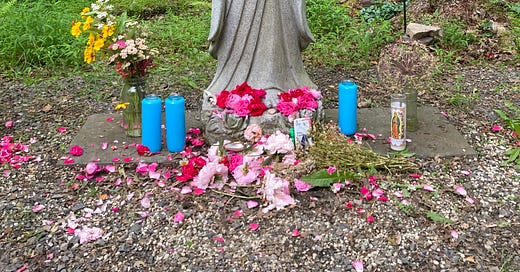Last weekend, I attended the feast day for Our Lady of Woodstock, site of an apparition of the Great Mother detailed by Clark Strand and
in their marvelous book The Way of the Rose (highly recommended).I met Finn and Strand in the flesh for the first time last year, after having attended several of their Zoom rosary calls in the years leading up to the 2024 feast day, and they’d asked if I’d be willing to lead some of the ecstatic dances dedicated to the Black Madonna.
Studying in Italy and America, I found a tradition dating back to when Southern Italy was part of the ancient Greek empire, a tradition of drum and dance that survived the sword-point transition to Christianity, a mystic tradition that thrived in the Middle Ages and even managed to squeak past the hyper-rationalism brought about by the Age of Enlightenment (which never really reached the Italian south) and into the 20th-century. Still alive today, these dances and rhythms persist because we need the ecstatic, we need to be able to step out of stasis (“ecstasy” coming from the Greek ek, “out,” and histanai, “to place, cause to stand”), out of the administrative mind which runs every aspect of our lives, from household duties to jobs to relationships, all imbued with the dye of utility and commodification.
I led the attendees through a spinning dance from the Mezzogiorno, the Italian south, a dance where, Sufi-like, the people whirl and turn and spin, but here the goal is to spin out the poison of trauma, of emotional blockage, of relationships gone awry, of dreams deferred.
Fortunate to have guided multiple groups through the various dances associated with the Black Madonna, I am stunned to this day how well these techniques work on all types of people. I’ve done them with buttoned-up drones from the World Bank, the Department of Justice, the Congressional offices; with lawyers and lobbyists; with high-powered executives accustomed to working 12-hour days. More than the usual suspects – musicians, dancers, yoga practitioners, the mystic-obsessed like myself – it’s these people who affirm the capacity of the Black Madonna traditions to reach beyond the limitations thrust upon us by small-minded family and alleged friends, by a work system that rewards burnout, by a culture who urges us to disconnect from our hearts, our relationships, the earth, the currents of joy and sorrow.
Like the Black Madonna, these dances are about life – the good, the bad, the hideous, and the beautiful. All of us cradle a deep-rooted need for connection – to our deepest desires, to the erotic, to the numinous – which, too often, goes unfulfilled lifelong, the American dream nothing more than an opium-laced draught that numbs you as it kills you.
Read Barbara Ehrenreich’s fabulous book Dancing in the Streets: A Collective History of Joy to see what’s been taken from all of us, the history of ecstatic dance in Europe that still pulses in our blood. I’m convinced it’s this blood memory that resurrects whenever I play the drum for others and they fall into the movements they never were taught but are so familiar – the spinning, twitching, pumping, shaking, jumping –a wild expression of what’s slept for too long…
And what must, if we’re to survive a time that feels downright Medieval, wake up.





❤️❤️🖤🖤🌹🌹 thank you for immersing us in these ancient traditions Greg!